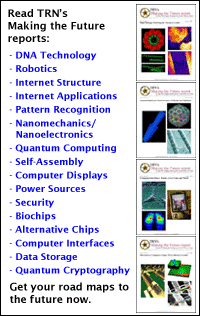
Neural-chaos team boosts security
By
Kimberly Patch,
Technology Research NewsIn old war movies, soldiers synchronized their watches before splitting up to carry out separate tasks on a mission. This gave them a common timeframe for coordinating their actions in the chaos of battle.
Modern-day researchers have shown that chaos itself can also be synchronized. This type of synchronization can be used to give people a common frame of reference that allows them to safeguard secret communications.
Researchers from Bar Ilan University in Israel have combined chaotic signal synchronization and a neural network encryption scheme in an effort to make a virtually unbreakable code. Neural networks mimic the structure of biological brains, which contain many relatively simple neurons connected to many other neurons.
The researchers' system involves a pair of synchronized systems -- one at the sender's location, and one at the receiver's location. The two parties use the systems to form encryption keys. The combined system dramatically lowers the risk of an eavesdropper being able to get a copy of a key.
Encrypting a message is simple -- replace the words with gibberish that corresponds to a random mathematical key, and give the intended receiver the key. The difficult part of successfully sending an encrypted message is finding a truly random source to generate a key and securely sending the key so that only the intended receiver has access to it.
Most random number generators are not truly random, which makes them theoretically predictable. Chaotic systems and neural networks are good random sources because they are complicated systems that are always changing.
One way to share a random source is to synchronize a pair of identical dynamic systems, one at the sender's location and one at the receiver's location.
Chaotic maps can be synchronized in a certain range of parameters. Each map starts out with random initial conditions, similar to a piece of paper with symbols scattered over the surface. After a period of receiving identical signals the maps gradually become identical for a certain range of parameters even though they started out differently and their dynamics remain chaotic.
Previous research has shown that it is possible to use synchronized chaotic signals to provide private-key encryption. If, for example, two people want to exchange a secret message and they have a way to synchronize their signals, the sender can add the message to the signal and the receiver can retrieve the message by subtracting the signal.
Neural networks can also be synchronized. Neural networks record changes in the number of connections between neurons, and synchronized networks have similar connections, or synaptic weights.
Previous research has shown that it is possible to synchronize neural networks by having them affect, or learn from, each other and the Bar Ilan researchers previously used neural network synchronization for encryption. "Both networks are dynamic and [pass] some information about their state to each other, until they reach a dynamic symmetric state of their synaptic weights," said Rachel Mislovaty, a researcher at Bar Ilan University. The symmetric weights achieved by the software are the encryption key, she said.
An eavesdropper could tap into this type of neural-network encryption scheme with his own neural network, but it takes longer for a passive network to synchronize to an active network than for the pair of active networks to synchronize to each other.
The researchers' have found a way to combine the neural and chaotic synchronization methods to enable keys that are even more eavesdropper-proof.
The researchers' combined encryption system includes a pair of software-based neural networks and a pair of chaotic maps.
The system uses the synchronized synaptic weights to construct the signal for the chaotic maps, said Mislovaty. The output from the maps, in turn, becomes the input for the neural networks. "As the synapses become more and more synchronized, the maps' signals become identical, causing the maps to synchronize as well," she said.
The combined systems synchronized faster than the neural-network signals alone, making it even less likely that an eavesdropper could store all the transmitted information that a key was drawn from. This makes it possible to generate shared secret encryption keys using an unsecure communications line.
That the hybrid network would synchronize was not so obvious, said Mislovaty. "This was not so obvious in the beginning since the two synchronization mechanisms can interfere with each other [and so not let] the whole network synchronize," she said.
It's too soon to tell when the cryptographic method could be used practically, said Mislovaty.
Mislovaty's research colleagues were Einat Klein and Ido Kanter from Bar Ilan University, and Wolfgang Kinzel from the University of Würzburg. The work appeared in the September 12, 2003 issue of Physical Review Letters. The research was funded by Bar Ilan University.
Timeline: Unknown
Funding: University
TRN Categories: Cryptography and Security; Neural Networks; Chaotic Systems, Fuzzy Logic and Probabilistic Reasoning
Story Type: News
Related Elements: Technical paper, "Public Channel Cryptography by Synchronization of Neural Networks and Chaotic Maps," Physical Review Letters, September 12, 2003
Advertisements:
January 28/February 4, 2004
Page One
Robot automates science
Chemicals map nanowire arrays
Badge controls displays
Neural-chaos team boosts security
Briefs:
Inkjet goes 3D
Nanotubes tied to silicon circuit
Micro tweezers have ice grip
Nanorings promise big memory
Protein orders semiconductor bits
Technique detects quantum state
News:
Research News Roundup
Research Watch blog
Features:
View from the High Ground Q&A
How It Works
RSS Feeds:
News
Ad links:
Buy an ad link
| Advertisements:
|
 |
Ad links: Clear History
Buy an ad link
|
TRN
Newswire and Headline Feeds for Web sites
|
© Copyright Technology Research News, LLC 2000-2006. All rights reserved.